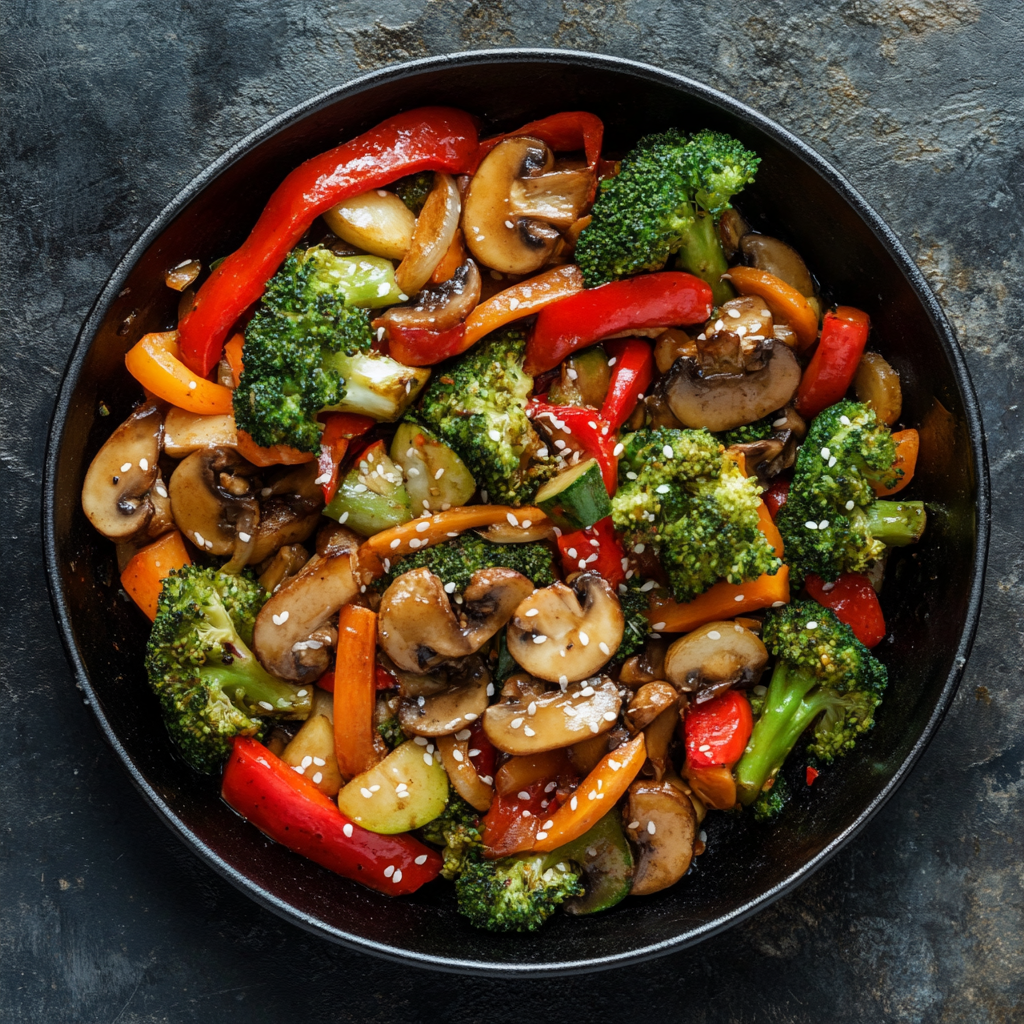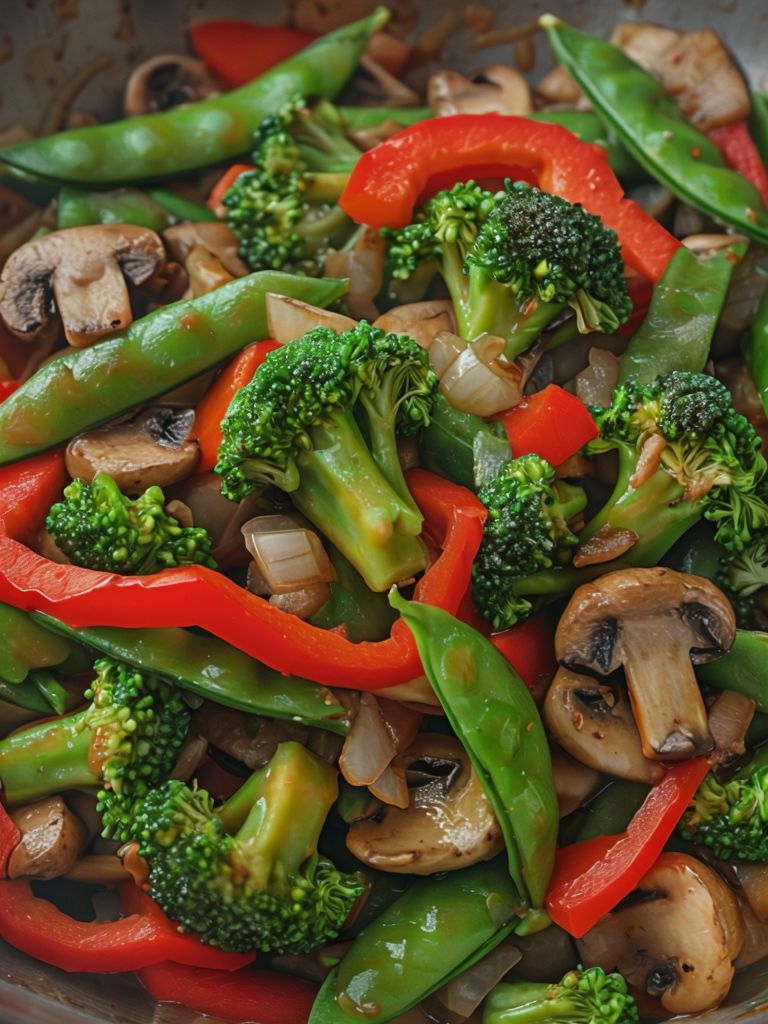Introduction to Vegetable Stir-Fry
What is a Vegetable Stir-Fry?
A vegetable stir-fry is a quick, flavorful dish that involves sautéing a medley of vegetables over high heat. The result? A delightful blend of crisp, colorful, and nutrient-packed vegetables coated in a savory sauce. It’s a dish celebrated for its versatility, as it can be tailored to individual tastes and dietary needs.
The Popularity of Stir-Fry Across Different Cultures
The stir-fry method originates from Chinese cooking, where the technique of « wok hei » – the breath of the wok – elevates flavors through high heat. Over time, this cooking style has been embraced by cuisines worldwide, from Thai and Japanese to Mediterranean and American kitchens. Its appeal lies in the speed and simplicity of preparation, making it a favorite for busy weeknights.
Why Choose a 30-Minute Recipe?
In today’s fast-paced world, finding time to prepare a nutritious meal can be challenging. A 30-minute vegetable stir-fry offers the perfect solution:
- Quick to prepare and cook.
- Packed with nutrients and antioxidants.
- Easily adaptable to what’s available in your pantry.
Whether you’re a seasoned home chef or a kitchen novice, this recipe ensures you’ll have a delicious meal on the table in no time.

Key Ingredients for a Perfect Stir-Fry
Essential Vegetables to Use
The beauty of a stir-fry lies in its flexibility, but certain vegetables shine in this dish for their texture and flavor. Some must-haves include:
- Bell peppers for sweetness and crunch.
- Broccoli and cauliflower for heartiness.
- Carrots for a subtle sweetness and vibrant color.
- Mushrooms for their umami depth.
- Snap peas for a fresh, crisp bite.
- Zucchini and squash for a soft, tender contrast.
Choosing the Right Proteins (Optional Add-ons)
While a vegetable stir-fry can stand alone, adding proteins creates a more filling dish. Some popular options include:
- Tofu: A plant-based favorite that absorbs flavors beautifully.
- Chicken: For a lean, protein-packed addition.
- Shrimp: Quick to cook and pairs perfectly with stir-fry sauces.
- Beef or pork strips: For a heartier, savory twist.
The Importance of Fresh Herbs and Aromatics
Herbs and aromatics are the soul of a stir-fry, imparting layers of flavor. Essential aromatics include:
- Garlic: Adds a punch of flavor.
- Ginger: Brings warmth and a hint of spice.
- Scallions or green onions: Perfect for a mild oniony kick.
- Cilantro or Thai basil: For a fresh, herby finish.
Equipment and Tools You Need
Wok vs. Skillet: Which is Better?
The traditional wok is the best tool for stir-frying, thanks to its:
- High, sloped sides that keep ingredients moving.
- Even heat distribution, essential for high-temperature cooking.
If a wok isn’t available, a large skillet with a flat base can work as a substitute. Look for one with:
- A wide surface area.
- A non-stick or carbon steel finish for easy stirring.
Essential Kitchen Utensils for Stir-Frying
To achieve a smooth cooking process, gather these tools:
- A sturdy spatula: For tossing ingredients effortlessly.
- Tongs: Ideal for grabbing and turning proteins or larger vegetables.
- Sharp knife: Ensures precise, even cutting of vegetables.
Preparing Your Workspace for Efficiency
Having a well-organized workspace is key to the quick pace of stir-frying. Follow these tips:
- Pre-chop all ingredients: Once cooking starts, there’s no time to stop and chop.
- Measure out sauces and seasonings: Have soy sauce, oyster sauce, or any other condiments ready.
- Keep your tools within reach: Quick access to utensils ensures smooth cooking.
The Science of Stir-Frying
Why High Heat is Essential
Cooking at high heat achieves two critical goals:
- Locks in flavor and texture: High temperatures sear the vegetables, retaining their crunch.
- Prevents sogginess: Quick cooking avoids overcooking, which can make vegetables limp.
Understanding the Role of Oil and Sauces
- Oil: Choose oils with high smoke points, like canola or peanut oil. They won’t burn under intense heat and add a subtle richness.
- Sauces: Soy sauce, hoisin sauce, and sesame oil provide umami and balance, creating the hallmark stir-fry taste.
The Order of Cooking: A Crucial Factor
The order in which ingredients are added is vital for texture and flavor:
- Start with aromatics (garlic, ginger).
- Add vegetables based on cooking time, starting with harder ones (carrots, broccoli) and finishing with softer ones (mushrooms, snap peas).
- Finish with the sauce to coat everything evenly.
30-Minute Vegetable Stir-Fry: A Flavor Explosion! (Continued)
Step-by-Step Recipe Guide
Prepping Your Vegetables
Preparation is the cornerstone of a successful stir-fry. Here’s how to set yourself up for success:
- Wash thoroughly: Clean vegetables under running water to remove dirt or pesticides.
- Cut uniformly: Chop vegetables into similar sizes to ensure even cooking.
- Hard vegetables like carrots and broccoli should be sliced thinner for quicker cooking.
- Softer vegetables, like zucchini or bell peppers, can be cut into slightly larger chunks.
Investing time in prep work will streamline the cooking process and give your stir-fry a professional touch.
Creating a Flavorful Stir-Fry Sauce
The sauce is where the magic happens. A simple, balanced stir-fry sauce often includes:
- Soy sauce (2 tbsp): The salty, umami foundation.
- Oyster sauce (1 tbsp): Adds a savory depth.
- Sesame oil (1 tsp): For a nutty aroma.
- Cornstarch (1 tsp): Thickens the sauce.
- Water or broth (2 tbsp): Adjusts the consistency.
- Optional extras: Chili paste, honey, or rice vinegar for added complexity.
Mix these ingredients in a small bowl beforehand so they’re ready to pour when needed.
Techniques for Cutting Ingredients Evenly
Uniform cutting is more than just aesthetics—it ensures even cooking. Some cutting tips include:
- Julienne carrots: Thin matchstick slices for quick cooking.
- Diagonal slicing: For long vegetables like zucchini or green beans, angled cuts create more surface area.
- Dicing onions and peppers: A consistent dice ensures they caramelize evenly.
Cooking the Stir-Fry
Heating the Wok and Adding Oil
Start by heating your wok or skillet over medium-high heat for about 1–2 minutes. Once it’s hot:
- Add 1–2 tablespoons of oil. Swirl to coat the surface evenly.
- Wait until the oil shimmers—this indicates it’s hot enough for cooking.
Sautéing Aromatics for a Flavor Boost
Aromatics are your first step in layering flavor. Toss in minced garlic, grated ginger, and chopped scallions. Cook for about 30 seconds to release their aroma. Be careful not to burn them, as burnt aromatics can impart a bitter taste.
Adding Vegetables in the Right Sequence
Cooking vegetables in the correct order ensures optimal texture. Follow this sequence:
- Hard vegetables first: Add broccoli, carrots, or cauliflower and stir for 2–3 minutes.
- Medium-density vegetables next: Bell peppers, mushrooms, or snap peas go in next, cooking for another 2 minutes.
- Soft vegetables last: Zucchini or leafy greens (like spinach) need just 1–2 minutes to cook through.
Mixing in the Sauce for Maximum Coating
Once the vegetables are almost done, pour in your pre-mixed sauce. Stir quickly to coat everything evenly. Let the sauce simmer for 1–2 minutes until slightly thickened.
Customizing Your Stir-Fry
Adding Proteins: Tofu, Chicken, or Shrimp
If you’d like to incorporate protein into your stir-fry, here’s how:
- Tofu: Press firm tofu to remove excess moisture, then cube it and sear before adding vegetables.
- Chicken or beef: Thinly slice for quick cooking. Cook fully before adding vegetables.
- Shrimp: Add during the last 3–4 minutes, as shrimp cooks rapidly.
Using Seasonal Vegetables for Variation
Seasonal vegetables not only taste better but are also budget-friendly. Try:
- Summer: Zucchini, corn, and tomatoes.
- Winter: Brussels sprouts, kale, and sweet potatoes.
Adjusting Spice Levels to Suit Your Taste
Customize the heat level with these additions:
- Mild: A dash of sweet chili sauce.
- Medium: Add crushed red pepper flakes.
- Spicy: Toss in fresh sliced chilies or chili paste.
Tips for Perfect Stir-Fry Every Time
How to Avoid Soggy Vegetables
- Don’t overcrowd the pan: Cook in batches if necessary.
- Dry vegetables thoroughly: Excess moisture can steam instead of sauté.
- Keep the heat high: High temperatures ensure crispness.
Timing Your Cook for Perfect Texture
Vegetables should retain a slight crunch. Overcooking leads to sogginess, so keep an eye on each ingredient’s doneness.
Mistakes to Avoid When Stir-Frying
- Using the wrong oil: Avoid olive oil—it has a low smoke point.
- Adding sauce too early: This can make the vegetables soggy.
- Skipping the prep stage: Chopping as you go disrupts the cooking flow.
30-Minute Vegetable Stir-Fry: A Flavor Explosion! (Continued)
Pairing and Serving Ideas
Best Sides for Your Vegetable Stir-Fry
A vegetable stir-fry can be a standalone dish or paired with sides for a more substantial meal. Here are some excellent options:
- Steamed rice: Classic white or brown rice is perfect for soaking up the savory sauce.
- Noodles: Toss your stir-fry with rice noodles, udon, or soba for an Asian-inspired twist.
- Quinoa: A high-protein grain that adds a nutty flavor and complements the vegetables.
- Cauliflower rice: A low-carb alternative to traditional grains.
Turning Stir-Fry Into a Complete Meal
Elevate your stir-fry into a one-bowl meal with these ideas:
- Protein boost: Add tofu, tempeh, or your choice of meat.
- Egg topping: Fry or poach an egg and place it on top of your stir-fry.
- Crunch factor: Sprinkle toasted sesame seeds or crushed peanuts for texture.
Garnishing Tips for Added Appeal
A well-garnished dish is not only visually appealing but also enhances flavor. Try:
- Fresh herbs: Cilantro, Thai basil, or green onions.
- Zest: A sprinkle of lemon or lime zest for brightness.
- Chili slices: For a pop of color and heat.
Health Benefits of Stir-Frying Vegetables
Nutritional Value of Common Stir-Fry Ingredients
Vegetables in stir-fry are powerhouses of vitamins and minerals:
- Broccoli: Packed with Vitamin C and calcium.
- Carrots: High in beta-carotene for eye health.
- Bell peppers: Loaded with antioxidants like Vitamin A and C.
- Mushrooms: A great source of Vitamin D and B vitamins.
Adding fresh vegetables ensures you’re fueling your body with nutrient-rich foods.
Why Stir-Frying is a Healthy Cooking Method
Stir-frying retains nutrients that are often lost in other cooking methods. Here’s why:
- Quick cooking time: Minimizes nutrient loss.
- Minimal oil: Requires just enough to coat the pan without deep frying.
- Retains texture: Preserves the crunch and freshness of vegetables.
How to Make Your Stir-Fry Lower in Calories
For a lighter version:
- Use less oil: Stick to 1 tablespoon or switch to a spray.
- Reduce sugar in sauces: Substitute with natural sweeteners like honey or skip it altogether.
- Double the vegetables: Increase the veggie-to-protein ratio for a low-calorie, filling dish.
Storage and Reheating Tips
Best Practices for Storing Leftovers
Keep your stir-fry fresh with these tips:
- Cool completely: Allow the stir-fry to cool before transferring it to an airtight container.
- Separate sides: Store rice or noodles separately to prevent sogginess.
- Refrigerate promptly: Consume within 3–4 days for optimal flavor and safety.
How to Reheat Stir-Fry Without Losing Texture
To retain the crunch and flavor:
- On the stove: Heat in a skillet over medium-high heat with a splash of oil or water.
- In the microwave: Use short intervals (30 seconds) and stir in between to avoid overcooking.
Creative Ways to Use Leftover Stir-Fry
Turn leftovers into entirely new meals:
- Stir-fry wraps: Spoon it into tortillas for an Asian-inspired wrap.
- Omelets: Fold stir-fry into beaten eggs for a hearty breakfast.
- Soup base: Add broth for a quick and flavorful vegetable soup.
Conclusion and Final Thoughts
Recap of the Recipe and Its Benefits
This 30-minute vegetable stir-fry combines speed, flavor, and nutrition in one simple dish. It’s a versatile recipe that can be tailored to any taste or dietary preference, making it an ideal choice for busy individuals.
Encouraging Creativity in Stir-Frying
The joy of stir-frying lies in experimentation. Try:
- Swapping out vegetables for seasonal produce.
- Adding unexpected spices like cumin or curry powder.
- Trying new protein sources like tempeh or chickpeas.
Inviting Readers to Experiment with Their Own Variations
No two stir-fries need to be alike! Whether you’re following the recipe to the letter or putting your twist on it, the possibilities are endless. Share your creations and enjoy the journey of making every stir-fry unique.
More FAQs
- Can I make stir-fry without a wok?
Absolutely! A large skillet with a flat base works well as a substitute. - What oil is best for stir-frying?
Oils with high smoke points like canola, peanut, or avocado oil are ideal. - How do I prevent my vegetables from getting soggy?
Cook at high heat and avoid overcrowding the pan. - Can I make a stir-fry sauce ahead of time?
Yes! Prepare and refrigerate it in a jar for up to a week. - Is stir-frying healthy?
Yes, it’s a quick-cooking method that preserves nutrients and requires minimal oil. - What proteins work best in stir-fry?
Tofu, chicken, shrimp, beef, pork, or even chickpeas are excellent options. - How can I thicken my stir-fry sauce?
Use cornstarch or arrowroot mixed with water before adding it to the stir-fry. - What’s the best way to cut vegetables for stir-fry?
Uniform, bite-sized pieces ensure even cooking and easy eating. - Can I freeze leftover stir-fry?
While fresh is best, stir-fry can be frozen for up to 2 months. Reheat directly from frozen for best results. - What are common mistakes in stir-frying?
Overcrowding the pan, using too much sauce, or cooking at low heat can compromise the dish.

